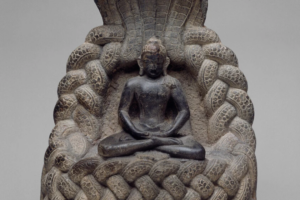The remains of early Ku Klux Klan leader and Confederate Gen. Nathan Bedford Forrest were finally being exhumed from a Memphis park, and the Black woman who led a long battle for the change was there to mark the moment.
But as activist-turned-elected-official Tami Sawyer prepared to address reporters, a man waved a Confederate flag behind her. Pacing back and forth, he called the Memphis city council member a “communist.” Then he started singing “Dixie,” the anthem of the Old South.
“This hatred and this racism is large and loud,” Sawyer said as he sang. She added, “I’m not going to let him win.”
The encounter on Tuesday cast a shadow over a day years in the making for activists and officials who pushed for Confederate symbols to be removed from public grounds in the majority-Black city. The movement, which came as communities across the South debated scrapping such memorials, succeeded only after a protracted legal battle.
“It was a moment that I thought would be celebratory,” Sawyer said in an interview with The Washington Post on Wednesday. “And thinking about the anniversary of Tulsa, thinking about Memorial Day, I just thought it was great timing. But then everything went left.”
Since 1904, the bodies of Forrest and his wife have laid in the city park that was named in his honor for more than a century. It’s the last remaining trace of the Confederate leader in what’s now known as Health Science Park after the earlier removal of a statue honoring him and a sign bearing his name.
One of the most notorious symbols of the Confederacy, Forrest has long been celebrated by Tennessee, his home state. Governors were required until last year to recognize July 13 as “Nathan Bedford Forrest Day,” lauding him as a “recognized military figure in American history.”
A wealthy enslaver and trader, Forrest enlisted in the Confederate States Army soon after the start of the Civil War. He rose to the rank of major general and led his troops in an 1864 attack that became known as the Fort Pillow Massacre.
The Civil War massacre that left nearly 200 black soldiers ‘murdered’
In a clash that would galvanize the Union cause, Forrest’s men killed as many as 300 Union soldiers, most of them Black. Robert S. Critchell, a naval officer, described the “merciless butchery” in a letter published soon after by the New York Times.
“I found many of the dead lying close along by the water’s edge, where they had evidently sought safety; they could not offer any resistance from the places where they were, in holes and cavilles along the banks,” he wrote. “Most of them had two wounds. I saw several colored soldiers of the Sixth United States Artillery, with their eyes punched out with bayonets; many of them were shot twice and bayonetted also.”
When the war was over, Forrest became the first grand wizard of the KKK. He left the role after about a year and later denounced the violence and racism of the Klan. But he has remained one of the most controversial figures of the Civil War era because of his role in the organization and the Fort Pillow Massacre.
Efforts to remove Forrest’s monument and remains have persisted for years in Memphis. But they took on a new fervor in 2017 after the deadly “Unite the Right” rally in Charlottesville. Sawyer, an educator and Memphis native, that year founded a group called Take ’Em Down 901 to advocate for the removal of Confederate iconography. The area code for Memphis is 901.
“The climate was right,” she said. “The timing was right.”
But it wasn’t easy — even with the City Council’s approval. A 2016 state law required that the Tennessee Historical Commission approve attempts to get rid of or modify monuments to historical figures, according to the Memphis Commercial Appeal. And in October 2017, the commission denied the city’s request to remove the Forrest statue.
Two months later, the Commercial Appeal reported, the City Council sold the park to a nonprofit called Greenspace. The sale allowed the statue to come down overnight because its private ownership meant it was no longer subject to state approval.
The Sons of Confederate Veterans opposed the move. Spokesperson Lee Millar told the New Tri-State Defender at the time that the City Council “broke the law in doing what they were doing.”
“There’s no reason to tear down history, to move statues,” he said. “Everyone’s history should be appreciated.”
The group sued, but lost in 2018. The Tennessee Supreme Court later declined to hear an appeal.
In 2019, Greenspace transferred the monument to the Sons of Confederate Veterans under a private agreement, according to the Commercial Appeal. The nonprofit then began focusing on the removal of the remains, which required approval from Forrest’s descendants and a court.
They eventually agreed to relocate them to a new location in Columbia, Tenn. Millar told reporters on Tuesday that Forrest’s family once thought his body “belonged here,” but that “things have changed.”
“The Forrest family felt that the remains of General Forrest and Mrs. Forrest should be someplace where he can be protected, respected and visited without any danger,” he said, “which is not the case here.”
Four years into the creation of Take ’Em Down 901, Sawyer said she didn’t anticipate the kind of confrontation that happened when she headed to the park Tuesday, during the dismantling. She said she “should always expect it, I guess, but I just didn’t.”
The man shouting at her was initially thought to be a member of the workers removing the remains, but Sawyer said she has since learned that he was not one of them. She has spoken to city police about the incident, during which she said he threatened her.
The man’s shouting left her shaken. But she said still sees the moment as a major victory, noting that the park once dedicated to a Confederate hero will host Juneteenth celebrations weeks from now.
“Hatefulness aside, this is big,” Sawyer said. “It’s historic.”




